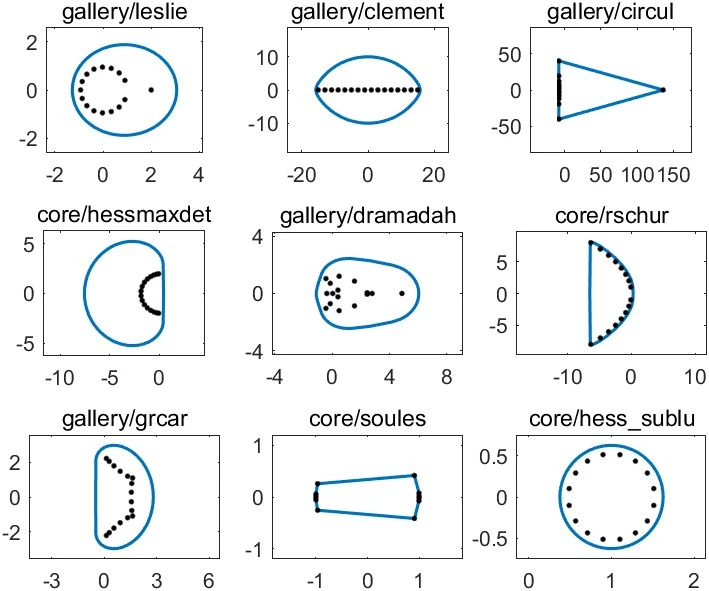The numerical range of a matrix , also known as the field of values, is the set of complex numbers
The set is compact and convex (a nontrivial property proved by Toeplitz and Hausdorff), and it contains all the eigenvalues of
. For normal matrices it is the convex hull of the eigenvalues. For a Hermitian matrix,
is a segment of the real axis, while for a skew-Hermitian matrix it is a segment of the imaginary axis.
The following figure plots in blue the boundaries of the the numerical ranges of nine matrices, with the eigenvalues shown as black dots. They were plotted using the function
fv in the Matrix Computation Toolbox. The matrices are from Anymatrix.

A method for computing the boundary of the numerical range is based on the observation that for any ,
This implies that the real part of lies between the largest and smallest eigenvalues of the Hermitian matrix
, which define a vertical strip in which the numerical range lies. Since
, we can apply the same reasoning to the rotated matrix
, and taking a range of
we obtain an approximation the boundary of the numerical range.
The quantity
is called the numerical abscissa, and by (1), is the largest eigenvalue of the Hermitian matrix
. The numerical abscissa determines the rate of growth of
for small positive
.
Associated with the numerical range is the numerical radius
Note that . Also,
, where
is the spectral radius (the largest absolute value of any eigenvalue), since
contains the eigenvalues of
.
The numerical radius differs by at most a factor from the
-norm:
When is normal,
.
The numerical radius is a matrix norm, but not a consistent norm (that is, does not hold in general). However, it is it true that
Combining this with with the lower bound in (2) gives
so if we know then we can bound
for all
.
The numerical radius can be characterized as the solution of an optimization problem over the Hermitian matrices:
Notes and References
For proofs of the results given here see Horn and Johnson (2013) or Horn and Johnson (1991), and see the latter for details of the algorithm for computing the numerical range. See Benzi (2020) for a discussion of applications of the numerical range in numerical analysis.
- Michele Benzi, Some Uses of the Field of Values in Numerical Analysis, Bollettino dell’Unione Matematica Italiana 14, 159–177, 2020.
- Roger Horn and Charles Johnson, Topics in Matrix Analysis, Cambridge University Press, 1991. Chapter 1.
- Roger A. Horn and Charles R. Johnson, Matrix Analysis, second edition, Cambridge University Press, 2013. My review of the second edition.
Related Blog Posts
- What Is a Matrix Norm? (2021)
- What Is an Eigenvalue? (2022)
This article is part of the “What Is” series, available from https://nhigham.com/category/what-is and in PDF form from the GitHub repository https://github.com/higham/what-is.
